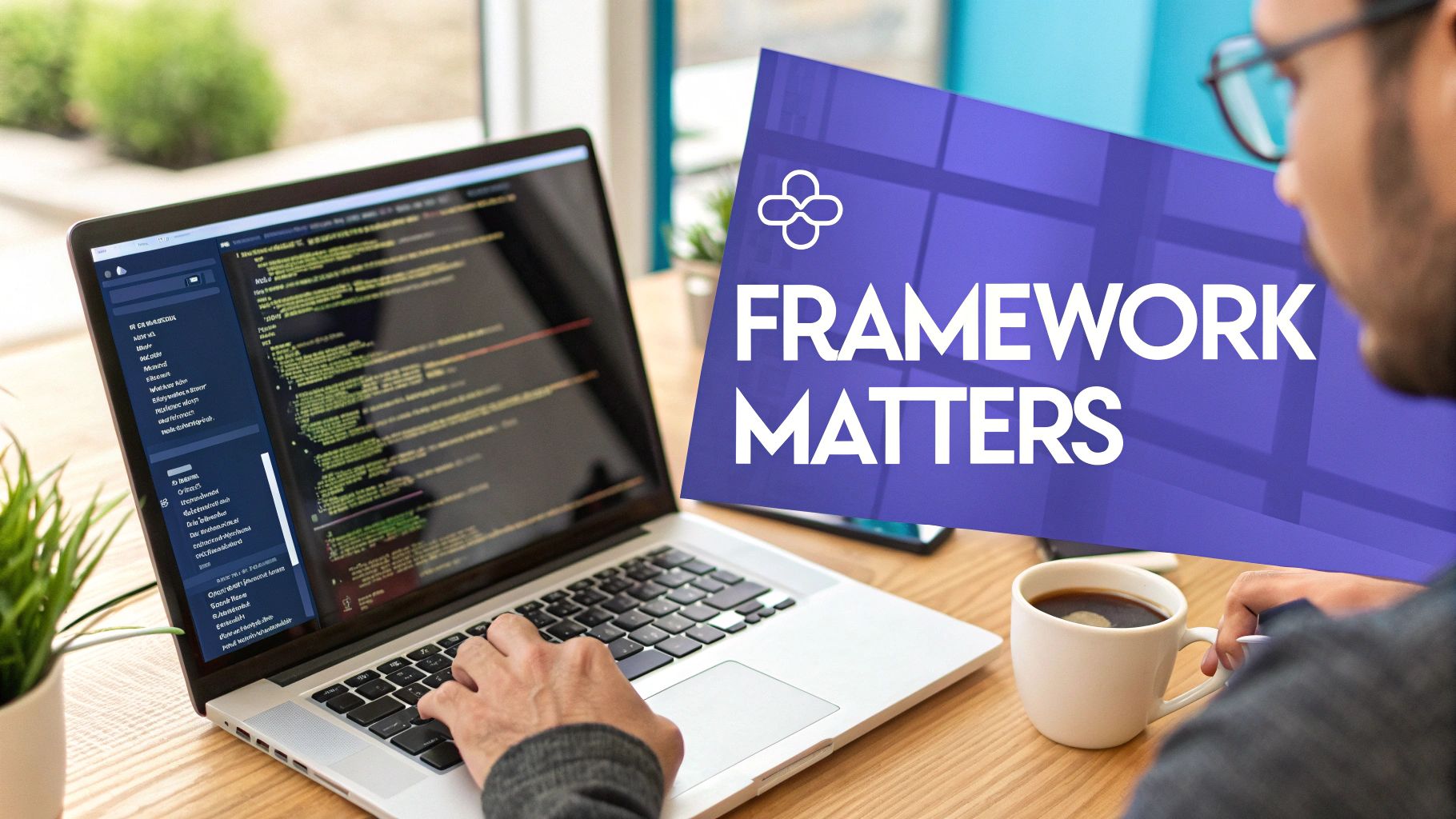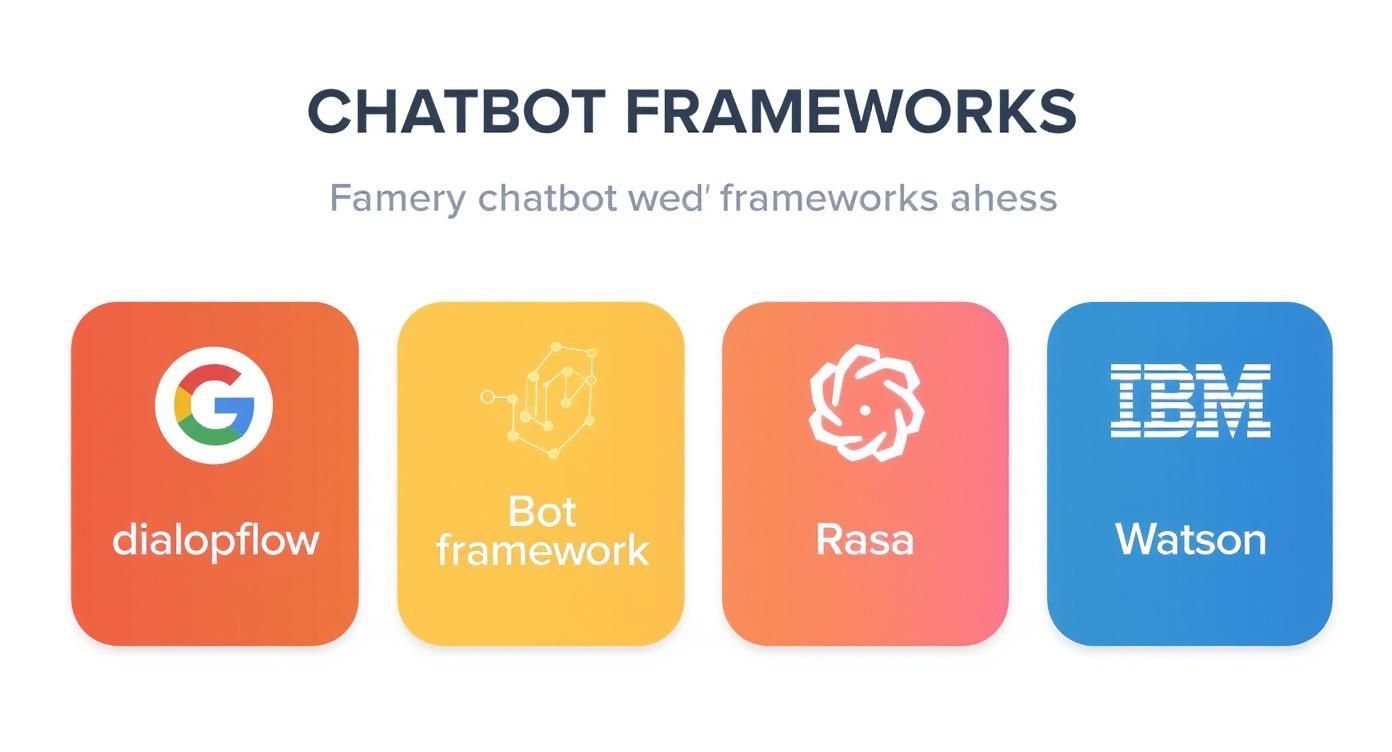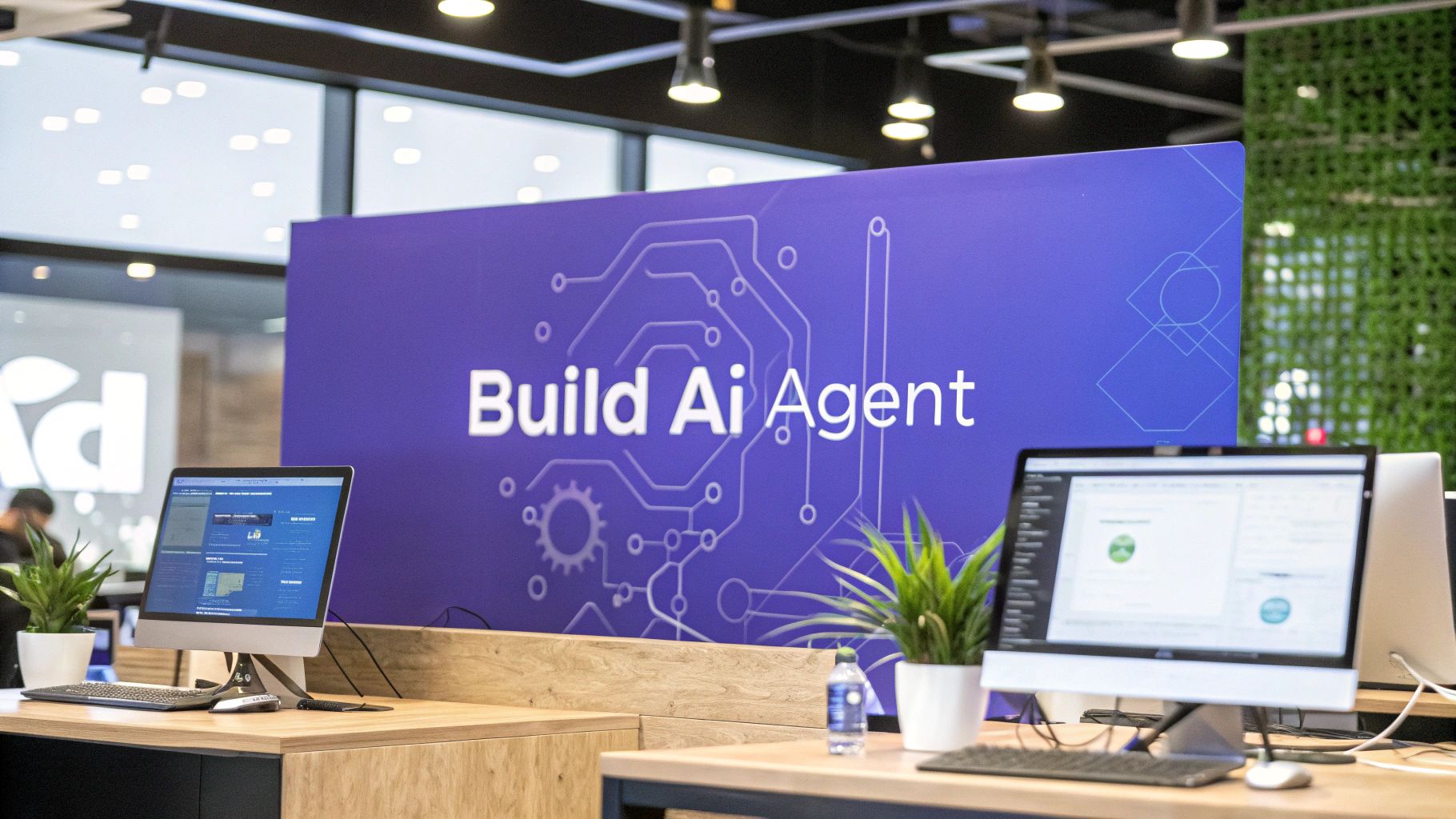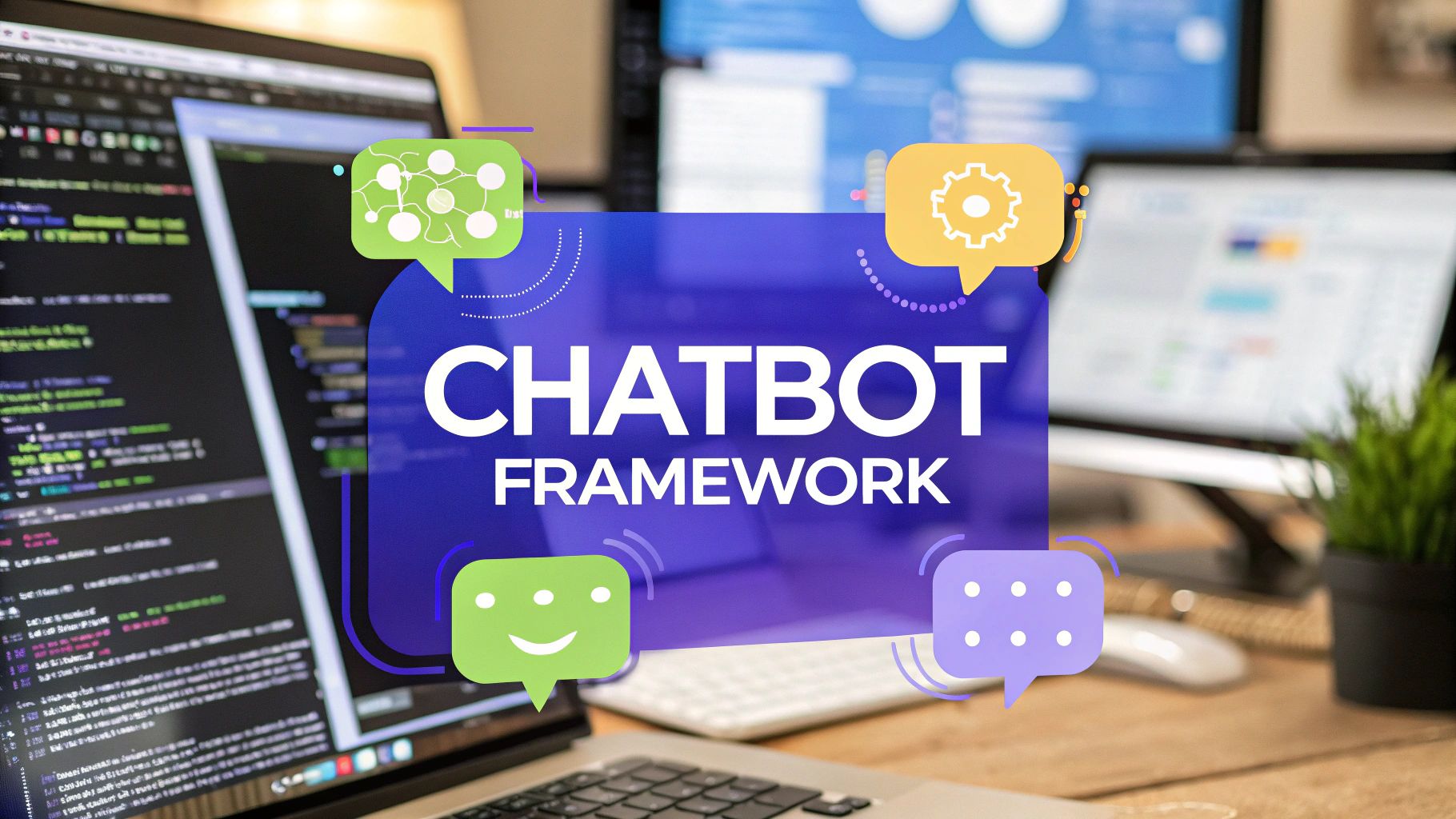Choosing Chatbot Development Frameworks for Your Business
Discover the best chatbot development frameworks. Our guide compares top platforms to help you select the right solution for your business goals.

Picking the right chatbot development framework is a big deal. The decision affects your entire project, from scalability and development costs to the quality of every customer interaction. In many ways, it's the foundation of your long-term AI strategy.
Why Your Choice of Chatbot Framework Matters

The chatbot market is booming for a reason. Businesses are using these tools to get a real leg up, automating tasks and engaging customers around the clock. By 2024, the market hit roughly $8.4 billion, and it’s not slowing down anytime soon. This growth shows how important these tools have become across nearly every industry.
Choosing the right framework is your first, and arguably most important, step. The framework provides the bones of your chatbot. It gives you the core tools and structure that influence everything from its intelligence to how it plugs into your other business systems. Your choice here will shape the entire development process and the end-user experience.
Aligning the Framework with Business Goals
Not all frameworks are created equal. Some are simple, no-code tools perfect for a marketing team that needs a lead-gen bot up and running by Friday. Others are powerful, open-source platforms designed for developers building highly specialized bots from the ground up.
The key is to match the tool to the job.
- Need to get a bot online fast? A managed, low-code platform is probably your best bet for a quick customer service win.
- Need total control and customization? An open-source framework is ideal for teams that want to fine-tune every detail and keep data in-house.
- Building something complex? A framework with robust, built-in AI capabilities is a must for handling tricky user requests.
Think of your framework choice as a strategic decision. It has to line up with your team’s technical skills, your budget, and what you actually want the chatbot to accomplish for the business.
Core Technologies Driving Modern Chatbots
One of the most important parts of any framework is how well it handles the foundational tech. A perfect example is Natural Language Processing (NLP), which allows a chatbot to understand and interpret what a person is actually saying.
The quality of a framework's NLP engine often determines how "smart" and genuinely helpful the bot feels to users. To get a better handle on the nuts and bolts, you can check out our guide on https://www.chatiant.com/blog/how-do-chatbots-work. Knowing these core concepts makes it much easier to see the real differences between the options we’re about to explore.
A Breakdown of Leading Chatbot Frameworks
Before we jump into a side-by-side comparison, let's get a quick lay of the land. The chatbot development frameworks market has a few major players, and each one is built with a different kind of user in mind. Knowing their core strengths will make the detailed analysis in the next section much easier to follow.
Google Dialogflow
Powered by Google's massive machine learning engine, Dialogflow provides powerful Natural Language Understanding (NLU) right out of the box. It’s a beast at figuring out what users actually mean, even when they use slang or informal language.
This makes it a go-to choice for businesses that want sophisticated conversational AI without having to build and train their own NLU models from scratch. If your team is already plugged into the Google ecosystem or needs a bot that can handle dozens of languages, Dialogflow is a natural fit. Its visual builder also opens the door for non-devs to design conversation flows.
Microsoft Bot Framework
The Microsoft Bot Framework is a developer-focused toolkit, especially for teams building on Azure. Think of it as a collection of services, including an open-source SDK and visual tools like the Bot Framework Composer.
This is really built for the enterprise crowd. If your organization runs on Microsoft services like Teams or Azure, the framework offers seamless integrations and a ton of power for building complex, channel-agnostic bots that can scale securely.
Rasa
Rasa is the undisputed leader in the open-source space. This means you get total control, from the machine learning models driving the conversation to where your data lives. For companies with strict data privacy rules or the need for deep, ground-up customization, Rasa is almost always the answer.
It's the perfect fit for a development team with Python skills that wants to own the entire chatbot pipeline. It’s more hands-on, for sure, but the flexibility is unmatched. You can also explore how to connect custom bots using an API chat bot.
Rasa is built for teams that prioritize control and customization. Instead of relying on a third-party service for language processing, you train and host your own models, giving you full ownership over your data and AI.
IBM Watson Assistant
IBM Watson Assistant is an enterprise-grade platform designed for building truly advanced AI assistants. It comes with a robust set of tools for creating complex, branching conversations and can plug into existing business systems to get real work done. While you're digging into different chatbot platforms, you might find it interesting to learn about the people behind them, like the co-founder and CEO of the Chatwoot platform.
Watson is designed for large organizations in heavily regulated industries like finance and healthcare. These are the companies that need a reliable, secure, and scalable solution with top-tier analytical capabilities.
Comparing Top Chatbot Frameworks Head-to-Head
Picking the right chatbot development framework is a technical decision that shapes how your conversational AI will perform, scale, and connect with your existing tools. Let’s break down the four heavy hitters: Google's Dialogflow, Microsoft Bot Framework, Rasa, and IBM Watson Assistant. We’ll put them side-by-side to see how they handle the things that really matter: Natural Language Understanding (NLU), developer experience, customization, and integrations.
This infographic gives a quick snapshot of where each framework fits and who it’s built for.

As you can see, there’s a clear split. Google and Microsoft offer powerful, enterprise-friendly cloud solutions, while Rasa champions a developer-first, open-source approach that puts you in total control.
To make things even clearer, here’s a quick overview of the key differences before we get specific.
At a Glance Comparing Chatbot Frameworks
This table offers a side-by-side look at the key features, target users, and ideal use cases for the top chatbot development frameworks. It’s a great starting point for figuring out which one aligns best with your team’s skills and project goals.
With that high-level view in mind, let's get into the specifics of what sets these platforms apart in practice.
Natural Language Understanding Performance
The heart of any chatbot is its brain, its ability to actually understand what people are saying. Each framework takes a different path here, creating a classic trade-off between out-of-the-box convenience and granular control.
Google's Dialogflow is a standout for its plug-and-play NLU. It’s powered by the same machine learning that drives Google’s core products, so it’s incredibly good at detecting intents and pulling out key information (entities) with very little training data. For businesses that need a bot that can handle a wide range of user inputs across multiple languages from day one, Dialogflow is a massive head start.
Rasa, on the other hand, hands you the keys. As an open-source framework, you’re in charge of training your NLU models from scratch with your own data. This is definitely more work upfront, but it gives you unparalleled control. You can fine-tune the model to understand niche industry jargon or unique conversational flows that off-the-shelf models would miss. It’s also a huge win for companies with strict data privacy requirements, since no user data ever needs to leave your servers.
Microsoft Bot Framework uses Azure's Language Understanding (LUIS) service, which offers a powerful, enterprise-grade NLU. It strikes a balance between Dialogflow and Rasa, providing solid pre-trained models that can still be heavily customized. IBM Watson Assistant is also known for its robust NLU, with a particular strength in handling disambiguation. When a user’s request is vague, it’s smart enough to ask for clarification instead of just giving up.
The Developer Learning Curve
How fast can your team actually start building something useful? The answer really depends on their existing skills and how complex the framework is.
Dialogflow offers the gentlest on-ramp, especially its ES version. The web-based interface and visual flow builders mean even non-coders can piece together a functional bot. This makes it perfect for rapid prototyping or for projects where engineering resources are tight.
Microsoft Bot Framework is more developer-focused, so you’ll need to be comfortable with C# or Node.js and the broader Azure ecosystem. Tools like the Bot Framework Composer offer a visual design canvas, but building a production-grade bot is a steeper climb.
Rasa has the most demanding learning curve of the four. It requires strong Python skills and a good handle on machine learning concepts. Here, developers own the entire pipeline, from preparing data and training models to deployment and ongoing maintenance. The reward for that effort is complete mastery over every aspect of your chatbot’s behavior.
The widespread use of frameworks like Google Dialogflow and open-source alternatives like Rasa are complemented by the rising dominance of GPT-based systems, marking a significant transition in chatbot development paradigms. This shift is supported by data showing over 4 million developers engaged in AI chatbot solutions worldwide, with enterprises increasingly investing in chatbot technologies as critical components of digital transformation strategies. To dig deeper into this trend, you can discover more insights about generative AI chatbots and their market impact.
Customization and Integration Options
A chatbot is rarely a standalone tool. Its real value comes from connecting to other systems to get things done, whether that’s looking up an order status or scheduling a meeting.
All four frameworks use webhooks and APIs for integrations, but their ecosystems and the ease of connecting to other services differ quite a bit.
- Dialogflow: Unsurprisingly, it integrates seamlessly with the Google Cloud Platform and has one-click integrations for tons of popular messaging apps.
- Microsoft Bot Framework: Its biggest advantage is its native integration with the entire Microsoft ecosystem, including Teams, Azure Active Directory, and Dynamics 365.
- IBM Watson Assistant: Built for the enterprise from the ground up, it has strong connectors for major CRM and ERP systems and puts a heavy emphasis on security.
- Rasa: Being open-source means you can connect it to literally anything with an API. This requires writing custom code, but it also means you’ll never hit a wall because of a missing pre-built integration.
For any business looking to connect a bot to external systems, knowing the role of a chat bot API is important. Our guide breaks down how these APIs act as the bridge between your chatbot and other software. Ultimately, your choice will come down to your specific tech stack and just how much control you need over the final product.
How to Budget for Chatbot Development
Figuring out what a chatbot will really cost goes way beyond the initial price tag. The true cost of ownership is wrapped up in the chatbot development framework you pick, and each comes with a totally different financial model.
Managed platforms like Google Dialogflow and IBM Watson Assistant usually run on subscription tiers or pay-as-you-go plans. This makes budgeting pretty straightforward at the start since you’re paying for what you use. The provider handles all the messy stuff: infrastructure, maintenance, and scaling. That is a huge plus for teams without a dedicated IT department to manage servers.
Pricing Models of Managed Platforms
The pricing for these managed services is all over the map. Dialogflow charges around $0.006 per message, while IBM Watson has plans starting around $90 monthly for business needs. Then you have Amazon Lex, with its pay-per-request model at a tiny $0.00075 each.
This kind of flexibility means businesses of all sizes can get a conversational agent up and running. But while these models give you predictable monthly expenses, the costs can definitely climb as your chatbot's popularity grows. It’s smart to forecast your expected message volume to avoid any sticker shock down the road.
The total cost of a managed platform isn't just the per-message fee. You also have to factor in the developer time spent integrating it with your systems. Setup is often faster, but complex connections still require skilled engineering work.
The Hidden Costs of Open-Source Frameworks
At first glance, open-source frameworks like Rasa look like a bargain because there are no licensing fees. But "free" is rarely ever free. The financial commitment just shifts from a subscription fee to operational expenses you have to cover yourself.
When you go the open-source route, you’re taking on full responsibility for a few key areas:
- Server Hosting: You’re on the hook for paying for the cloud or on-premise servers to run the chatbot. Those costs will scale right with your traffic.
- Skilled Developers: Rasa requires Python developers, often with a background in machine learning, who command higher salaries. Their time will be your single biggest expense.
- Ongoing Maintenance: Your team is in charge of all updates, security patches, and troubleshooting. This isn't a one-time task; it requires continuous developer hours.
This path gives you complete control and total data ownership, which can be a priceless advantage for some businesses. But it demands a significant investment, both upfront and ongoing, in talent and infrastructure. Your budget needs to account for salaries, server costs, and maintenance hours, not just the "free" software itself.
Matching the Framework to Your Business Needs

Moving from a list of features to a real-world decision helps clarify which chatbot development framework actually makes sense for you. The best choice almost always comes down to your industry, your team's skills, and what you’re trying to accomplish.
Let's look at how different businesses might pick a framework to solve their own unique problems. These examples show that the decision isn't about which framework is "best" overall, but which one is the right tool for the job at hand.
E-commerce and Rapid Deployment
An e-commerce brand wants to improve its customer experience with a bot that can act as a product finder and answer common order questions. Speed is a huge factor here, and so is the ability to connect to other services for live inventory and shipping updates.
For a business like this, Google Dialogflow is often a strong contender. It plugs right into Google's ecosystem and comes with powerful language models ready to go. This means the e-commerce company can launch a bot that actually understands what customers want without spending months on training.
A key advantage for an online store is the ability to get a smart assistant in front of customers fast. Dialogflow’s pre-trained models and integration options are built for this kind of quick, effective deployment.
Healthcare and Data Security
Now, let’s flip the script and look at a healthcare organization. Their top priorities are completely different. They need a chatbot that can handle sensitive patient information securely and comply with strict data privacy regulations. Control over the data isn't just a preference, it's a requirement.
This is where an open-source framework like Rasa becomes the obvious choice. Because Rasa can be deployed on-premise, all patient conversations and data stay within the organization's private servers. Nothing leaves their control.
Here’s why that matters:
- Total Data Ownership: No information is ever sent to a third-party cloud service, which is a deal-breaker for healthcare.
- Deep Customization: The bot's logic can be fine-tuned to handle specific medical terminology and complex patient intake flows.
- High Security: The development team has full control over the security measures protecting the chatbot and its data.
The broader adoption of chatbots really highlights their importance, especially in sectors with high customer interaction. Over 60% of large enterprises now use them, and in banking and financial services in North America, that number jumps to an incredible 92%. This trend points to the massive impact these tools have on how businesses operate. You can read more about chatbot adoption rates to see how they're changing different industries.
How to Make Your Final Decision
Picking the right chatbot development framework really just comes down to one thing: matching the tool to your specific project. Don't waste time looking for a single "best" option. Your goal is to find the best fit for your team, your budget, and what you’re trying to build. A little structured thinking here will save you a ton of guesswork later.
The easiest way to do this is to ask yourself a few direct questions. Your answers will create a clear profile of your needs, pointing you straight to the most logical framework. Think of it like creating a blueprint before you start pouring the foundation.
Key Questions to Guide Your Choice
First, get real about your internal resources and limitations. An honest look at your team’s skills and budget right now will prevent some major headaches down the road.
What’s our team’s actual technical skill level? If you have a crew of skilled Python developers ready to build from scratch, an open-source framework like Rasa gives you total control. But if your team is mostly marketers or business analysts, a low-code platform like Dialogflow will get you results so much faster.
How much control do we need over our data and privacy? For industries like healthcare or finance, this is a non-negotiable. Self-hosting with Rasa keeps every bit of conversation data on your own servers, period. If you're comfortable with a trusted cloud provider, managed platforms like IBM Watson or Microsoft Bot Framework are solid, secure choices.
Answering just these two questions can narrow your options in a hurry. For example, a small team without deep coding skills that needs a bot live in two weeks can immediately rule out complex, open-source tools and focus on managed, user-friendly platforms.
Aligning Frameworks with Project Goals
Next up, think about what this chatbot will actually do and how it will plug into your existing software. The right framework won’t just build a great bot. It will also play nice with the tools you already rely on every day.
What’s our real budget for setup and ongoing maintenance? Managed platforms come with predictable, usage-based pricing. Open-source options have no license fees, but you have to factor in developer salaries, server hosting, and all the time spent on maintenance. Make sure you calculate the total cost of ownership for both models before making a call.
What other software does our bot need to talk to? If your business lives and breathes the Microsoft ecosystem, the Bot Framework’s built-in integrations are a massive advantage. On the other hand, if you need to connect to a bunch of custom or third-party APIs, the raw flexibility of an open-source framework might make more sense.
By working through these questions one by one, you’ll shift from a vague feature comparison to a focused decision based on your unique reality. This simple, methodical approach ensures the chatbot framework you choose becomes a strategic asset, not just another piece of tech.
A Few Common Questions About Chatbot Frameworks
When you’re digging into different chatbot development frameworks, a few questions always seem to pop up. Let's get you some quick, clear answers to help you lock in your decision.
Can I Switch Chatbot Frameworks Later On?
You can, but it’s rarely a simple copy-paste job. Think of it less like moving furniture and more like rebuilding your house on a totally new foundation. You’ll almost certainly have to rewrite your conversation logic and retrain your NLU models, even if you can bring your old data along.
Honestly, migrating can be a massive project. It’s almost always better to invest more time upfront to get the framework right than to assume you can just switch later. A move really only makes sense if your business needs have completely changed or you’ve pushed your current solution so far past its limits that you have no other choice.
What's the Difference Between a Framework and a Platform?
This one trips a lot of people up, especially since the terms get thrown around together. They’re definitely not the same thing.
- A framework (like Rasa or the guts of Microsoft Bot Framework) is essentially a toolkit for developers. It gives you the core libraries and components to build a chatbot from the ground up, giving you maximum control.
- A platform (like Dialogflow or IBM Watson Assistant) is a more complete, managed service. It handles the hosting, gives you a user interface to build with, and comes with pre-built NLU, so you can get something running much faster with less code.
Put it this way: a framework gives you the engine and the chassis to build your own car. A platform sells you a car that you can customize with different paint colors and features.
How Much Technical Skill Do I Actually Need?
The skill level you’ll need depends entirely on the tool you pick. The good news is that the spectrum is incredibly wide, making chatbot development accessible to just about anyone.
On one end, you have low-code platforms like Dialogflow ES with visual builders that let non-developers create simple but effective bots. You can map out conversation flows and train intents without writing a single line of code.
On the other end, powerful open-source frameworks like Rasa demand strong programming skills, usually Python. Building with these tools means getting your hands dirty with machine learning concepts, data preparation, and managing your own server infrastructure.
Ready to build an AI agent that does more than just chat? With Chatiant, you can create a custom chatbot trained on your data, connect it to your business tools, and automate real work. https://www.chatiant.com


